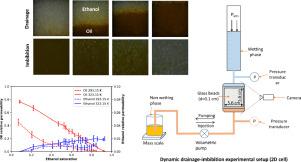当前位置:
X-MOL 学术
›
Adv. Water Resour.
›
论文详情
Our official English website, www.x-mol.net, welcomes your
feedback! (Note: you will need to create a separate account there.)
Experimental study of the temperature effect on two-phase flow properties in highly permeable porous media: Application to the remediation of dense non-aqueous phase liquids (DNAPLs) in polluted soil
Advances in Water Resources ( IF 4.0 ) Pub Date : 2020-12-01 , DOI: 10.1016/j.advwatres.2020.103783 Nicolas Philippe , Hossein Davarzani , Stéfan Colombano , Malorie Dierick , Pierre-Yves Klein , Manuel Marcoux
Advances in Water Resources ( IF 4.0 ) Pub Date : 2020-12-01 , DOI: 10.1016/j.advwatres.2020.103783 Nicolas Philippe , Hossein Davarzani , Stéfan Colombano , Malorie Dierick , Pierre-Yves Klein , Manuel Marcoux

|
Abstract The remediation of aquifers contaminated by viscous dense non-aqueous phase liquids (DNAPLs) is a challenging problem. Coal tars are the most abundant persistent DNAPLs due to their high viscosity and complexity. Pumping processes leave considerable volume fractions of DNAPLs in the soil and demand high operational costs to reach cleaning objectives. Thermally enhanced recovery focuses on decreasing DNAPL viscosity to reduce residual saturation. The oil industry has previously applied this technique with great success for enhanced oil recovery applications. However, in soil remediation, high porous media permeabilities and product densities may invalidate those techniques. Additionally, the impacts of temperature on coal tar's physical properties have not been thoroughly discussed in available literature. Here, we investigated how coal tar's physical properties, the capillary pressure-saturation curve and the relative permeability of two-phase flow in porous media depend on the temperature and flow rate experimentally. Drainage and imbibition experiments under quasi-static (steady-state) and dynamic (unsteady-state) conditions have been carried out at 293.15 K and 323.15 K in a 1D small cell filled with 1 mm homogeneous glass beads. Two different pairs of immiscible fluids have been investigated, coal tar-water and canola oil-ethanol. Results demonstrated similar trends for temperature effect and values of fluid properties for both liquid pairs, which backs up the use of canola oil-ethanol to model coal tar-water flow. It was found that there is no temperature effect on drainage-imbibition curves or residual saturation under quasi-static conditions. In dynamic conditions, the DNAPL residual saturation decreased by 16 % when the temperature changed from 293.15 K to 323.15 K. This drop was mainly linked to decreasing viscous fingering, as well as the appearance of wetting phase films around the glass beads. Both phenomena have been observed only in dynamic experiments. A high enough pumping flow rate is needed to generate dynamic effects in the porous medium. Ethanol and oil's relative permeabilities also increase with temperature under dynamic measurement conditions. Our findings indicate that flow rate is an important parameter to consider in thermal enhanced recovery processes. These effects are not taken into account in the classically used generalized Darcy's law for modeling two-phase flow in porous media with temperature variation.
中文翻译:

温度对高渗透多孔介质两相流动特性影响的实验研究:在污染土壤中修复致密非水相液体 (DNAPLs) 中的应用
摘要 修复被粘性稠密非水相液体 (DNAPLs) 污染的含水层是一个具有挑战性的问题。由于煤焦油的高粘度和复杂性,煤焦油是最丰富的持久性 DNAPL。泵送过程会在土壤中留下大量体积分数的 DNAPL,并且需要高昂的运营成本才能达到清洁目标。热增强采收率侧重于降低 DNAPL 粘度以降低残余饱和度。石油工业此前已将该技术应用于提高石油采收率的应用中,并取得了巨大成功。然而,在土壤修复中,高多孔介质渗透率和产品密度可能会使这些技术无效。此外,温度对煤焦油物理性质的影响尚未在现有文献中进行彻底讨论。这里,我们通过实验研究了煤焦油的物理性质、毛细管压力-饱和曲线和多孔介质中两相流的相对渗透率如何依赖于温度和流速。在 293.15 K 和 323.15 K 下,在填充有 1 mm 均质玻璃珠的 1D 小池中进行了准静态(稳态)和动态(非稳态)条件下的排水和渗吸实验。研究了两对不同的不混溶流体,煤焦油-水和菜籽油-乙醇。结果表明两种液体对的温度效应和流体特性值的趋势相似,这支持使用菜籽油-乙醇来模拟煤焦油-水流。结果表明,在准静态条件下,温度对排水-渗吸曲线或残余饱和度没有影响。在动态条件下,当温度从 293.15 K 变为 323.15 K 时,DNAPL 残余饱和度下降了 16%。这种下降主要与粘性指法的减少以及玻璃珠周围润湿相膜的出现有关。这两种现象都只在动态实验中观察到。需要足够高的泵送流速才能在多孔介质中产生动态效应。在动态测量条件下,乙醇和油的相对渗透率也随着温度的升高而增加。我们的研究结果表明,流速是在热强化采收过程中需要考虑的重要参数。在模拟多孔介质中随温度变化的两相流时,经典使用的广义达西定律没有考虑这些影响。当温度从 293.15 K 变为 323.15 K 时,DNAPL 残余饱和度下降了 16%。这种下降主要与粘性指法的减少以及玻璃珠周围润湿相膜的出现有关。这两种现象都只在动态实验中观察到。需要足够高的泵送流速才能在多孔介质中产生动态效应。在动态测量条件下,乙醇和油的相对渗透率也随着温度的升高而增加。我们的研究结果表明,流速是在热强化采收过程中需要考虑的重要参数。在模拟多孔介质中随温度变化的两相流时,经典使用的广义达西定律没有考虑这些影响。当温度从 293.15 K 变为 323.15 K 时,DNAPL 残余饱和度下降了 16%。这种下降主要与粘性指法的减少以及玻璃珠周围润湿相膜的出现有关。这两种现象都只在动态实验中观察到。需要足够高的泵送流速才能在多孔介质中产生动态效应。在动态测量条件下,乙醇和油的相对渗透率也随着温度的升高而增加。我们的研究结果表明,流速是在热强化采收过程中需要考虑的重要参数。在模拟多孔介质中随温度变化的两相流时,经典使用的广义达西定律没有考虑这些影响。15 K。这种下降主要与粘性指法的减少以及玻璃珠周围润湿相膜的出现有关。这两种现象都只在动态实验中观察到。需要足够高的泵送流速才能在多孔介质中产生动态效应。在动态测量条件下,乙醇和油的相对渗透率也随着温度的升高而增加。我们的研究结果表明,流速是在热强化采收过程中需要考虑的重要参数。在模拟多孔介质中随温度变化的两相流时,经典使用的广义达西定律没有考虑这些影响。15 K。这种下降主要与粘性指法的减少以及玻璃珠周围润湿相膜的出现有关。这两种现象都只在动态实验中观察到。需要足够高的泵送流速才能在多孔介质中产生动态效应。在动态测量条件下,乙醇和油的相对渗透率也随着温度的升高而增加。我们的研究结果表明,流速是在热强化采收过程中需要考虑的重要参数。在模拟多孔介质中随温度变化的两相流时,经典使用的广义达西定律没有考虑这些影响。这两种现象都只在动态实验中观察到。需要足够高的泵送流速才能在多孔介质中产生动态效应。在动态测量条件下,乙醇和油的相对渗透率也随着温度的升高而增加。我们的研究结果表明,流速是在热强化采收过程中需要考虑的重要参数。在模拟多孔介质中随温度变化的两相流时,经典使用的广义达西定律没有考虑这些影响。这两种现象都只在动态实验中观察到。需要足够高的泵送流速才能在多孔介质中产生动态效应。在动态测量条件下,乙醇和油的相对渗透率也随着温度的升高而增加。我们的研究结果表明,流速是在热强化采收过程中需要考虑的重要参数。在模拟多孔介质中随温度变化的两相流时,经典使用的广义达西定律没有考虑这些影响。我们的研究结果表明,流速是在热强化采收过程中需要考虑的重要参数。在模拟多孔介质中随温度变化的两相流时,经典使用的广义达西定律没有考虑这些影响。我们的研究结果表明,流速是在热强化采收过程中需要考虑的重要参数。在模拟多孔介质中随温度变化的两相流时,经典使用的广义达西定律没有考虑这些影响。
更新日期:2020-12-01
中文翻译:

温度对高渗透多孔介质两相流动特性影响的实验研究:在污染土壤中修复致密非水相液体 (DNAPLs) 中的应用
摘要 修复被粘性稠密非水相液体 (DNAPLs) 污染的含水层是一个具有挑战性的问题。由于煤焦油的高粘度和复杂性,煤焦油是最丰富的持久性 DNAPL。泵送过程会在土壤中留下大量体积分数的 DNAPL,并且需要高昂的运营成本才能达到清洁目标。热增强采收率侧重于降低 DNAPL 粘度以降低残余饱和度。石油工业此前已将该技术应用于提高石油采收率的应用中,并取得了巨大成功。然而,在土壤修复中,高多孔介质渗透率和产品密度可能会使这些技术无效。此外,温度对煤焦油物理性质的影响尚未在现有文献中进行彻底讨论。这里,我们通过实验研究了煤焦油的物理性质、毛细管压力-饱和曲线和多孔介质中两相流的相对渗透率如何依赖于温度和流速。在 293.15 K 和 323.15 K 下,在填充有 1 mm 均质玻璃珠的 1D 小池中进行了准静态(稳态)和动态(非稳态)条件下的排水和渗吸实验。研究了两对不同的不混溶流体,煤焦油-水和菜籽油-乙醇。结果表明两种液体对的温度效应和流体特性值的趋势相似,这支持使用菜籽油-乙醇来模拟煤焦油-水流。结果表明,在准静态条件下,温度对排水-渗吸曲线或残余饱和度没有影响。在动态条件下,当温度从 293.15 K 变为 323.15 K 时,DNAPL 残余饱和度下降了 16%。这种下降主要与粘性指法的减少以及玻璃珠周围润湿相膜的出现有关。这两种现象都只在动态实验中观察到。需要足够高的泵送流速才能在多孔介质中产生动态效应。在动态测量条件下,乙醇和油的相对渗透率也随着温度的升高而增加。我们的研究结果表明,流速是在热强化采收过程中需要考虑的重要参数。在模拟多孔介质中随温度变化的两相流时,经典使用的广义达西定律没有考虑这些影响。当温度从 293.15 K 变为 323.15 K 时,DNAPL 残余饱和度下降了 16%。这种下降主要与粘性指法的减少以及玻璃珠周围润湿相膜的出现有关。这两种现象都只在动态实验中观察到。需要足够高的泵送流速才能在多孔介质中产生动态效应。在动态测量条件下,乙醇和油的相对渗透率也随着温度的升高而增加。我们的研究结果表明,流速是在热强化采收过程中需要考虑的重要参数。在模拟多孔介质中随温度变化的两相流时,经典使用的广义达西定律没有考虑这些影响。当温度从 293.15 K 变为 323.15 K 时,DNAPL 残余饱和度下降了 16%。这种下降主要与粘性指法的减少以及玻璃珠周围润湿相膜的出现有关。这两种现象都只在动态实验中观察到。需要足够高的泵送流速才能在多孔介质中产生动态效应。在动态测量条件下,乙醇和油的相对渗透率也随着温度的升高而增加。我们的研究结果表明,流速是在热强化采收过程中需要考虑的重要参数。在模拟多孔介质中随温度变化的两相流时,经典使用的广义达西定律没有考虑这些影响。15 K。这种下降主要与粘性指法的减少以及玻璃珠周围润湿相膜的出现有关。这两种现象都只在动态实验中观察到。需要足够高的泵送流速才能在多孔介质中产生动态效应。在动态测量条件下,乙醇和油的相对渗透率也随着温度的升高而增加。我们的研究结果表明,流速是在热强化采收过程中需要考虑的重要参数。在模拟多孔介质中随温度变化的两相流时,经典使用的广义达西定律没有考虑这些影响。15 K。这种下降主要与粘性指法的减少以及玻璃珠周围润湿相膜的出现有关。这两种现象都只在动态实验中观察到。需要足够高的泵送流速才能在多孔介质中产生动态效应。在动态测量条件下,乙醇和油的相对渗透率也随着温度的升高而增加。我们的研究结果表明,流速是在热强化采收过程中需要考虑的重要参数。在模拟多孔介质中随温度变化的两相流时,经典使用的广义达西定律没有考虑这些影响。这两种现象都只在动态实验中观察到。需要足够高的泵送流速才能在多孔介质中产生动态效应。在动态测量条件下,乙醇和油的相对渗透率也随着温度的升高而增加。我们的研究结果表明,流速是在热强化采收过程中需要考虑的重要参数。在模拟多孔介质中随温度变化的两相流时,经典使用的广义达西定律没有考虑这些影响。这两种现象都只在动态实验中观察到。需要足够高的泵送流速才能在多孔介质中产生动态效应。在动态测量条件下,乙醇和油的相对渗透率也随着温度的升高而增加。我们的研究结果表明,流速是在热强化采收过程中需要考虑的重要参数。在模拟多孔介质中随温度变化的两相流时,经典使用的广义达西定律没有考虑这些影响。我们的研究结果表明,流速是在热强化采收过程中需要考虑的重要参数。在模拟多孔介质中随温度变化的两相流时,经典使用的广义达西定律没有考虑这些影响。我们的研究结果表明,流速是在热强化采收过程中需要考虑的重要参数。在模拟多孔介质中随温度变化的两相流时,经典使用的广义达西定律没有考虑这些影响。











































 京公网安备 11010802027423号
京公网安备 11010802027423号